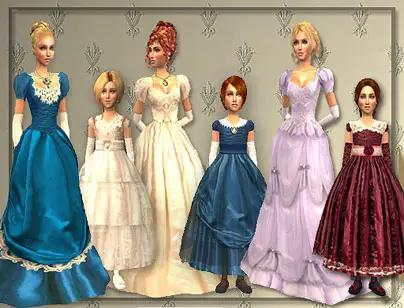
The women’s costumes underwent radical changes in the Victorian era. The dresses worn by women in the early Victorian period showed resemblance to those worn by women in the Georgian age. Etiquette was an important factor in the case of Victorian clothing. The dresses worn by women covered their entire body. It was prohibited for a woman to even show her ankles. The corsets during Victorian times restricted the movements of a woman.
Victorian woman’s fashion was many layers of dresses, skirts, blouses, coats, wraps, petticoats, corset, jewellery, and accessories worn after one after the other. It was an elaborate affair.
Here is a complete guide to women’s fashion of the Victorian era with facts about head to toe dressing up, its history and pictures
Underwears – Stockings, Petticoats, Chemise
Drawers or bloomers were the first things ladies would put up. Construction was with two separate legs joined at the waist and held in place with a drawstring or buttons. Center seam was left open for using the chamber pot. Once a tight corset on, pulling down her drawers was almost impossible for the lady.
The construction material of underclothes for the upper class was linen or silk and for the lower class, it was cotton or linen. Then it would be the Silk stockings that were held up by garters which tied around the leg just above or below the knee. During winters, instead of silk, it would be thicker woollen stockings to keep warm.
Then there was the chemise. It was silk or fine cotton one-piece, sleeveless shift with round neck and trimmed with lace. A corset would come on top of this. It would fit from the waist to under the chest (under the breasts). Sometimes it was tightly laced to ensure a tiny waist, and it also pushed the breasts up and together to create a cleavage.
The corset was nicely decorated and had pockets to hold whalebone or metal strips to ensure that the garment held its shape. Stepping into one of the many rustling petticoats (from three to six), which were starched to create a bell shape for the skirt. Over-petticoat was the last petticoat which was made of silk, satin, or cotton. It used to be lavishly decorated with ribbons and laces.
The outer layer of ladies’ clothing depended on the time of day and the season. Clothing was made for morning or afternoon wear, for a walk, or horse riding. Evening wear was either an evening gown or a ball gown. Shawls were popularly worn both during the day or at night.
Women’s fashion from morning till night
Called “at home” dress, a morning dress was usually a simple garment. Usually, it had long sleeves, high neckline with little or no trimming. The hem would just touch the floor, and a small train was no uncommon.
The richer fabric was used to make walking dresses which had little shorter hem for easy movement, and there was no train.
Afternoon dresses were usually lavishly trimmed, with low necklines. The sumptuous fabric was typically used and often with a train. Ladies would dress-up in these either for visiting friends or for receiving friends at home. Level of Lavishness of the dress would match with the rank of the people that you were to visit.
Evening or dinner gowns were had high necklines and were created with lush fabrics like satins and silks and tended to have sleek silhouettes. The sleeves were long without lavish decoration, to avoid dinner table accidents.
Crinoline was one of the extreme fashion of the era. This huge wicker or whalebone petticoat used to be hung at the waist and was covered by a very big skirt. Moving around was really difficult for the ladies. Use of candles and fires would mean these were completely unsafe since prone to catching fire. The wide crinoline emerged around the middle of the 19th century, and within 20 years it gave way to the bustle.
Victorian Era Women’s Fashion: Gowns
During the initial years of the Victorian rule, namely the 1840 and 1850 period, the gowns worn by women were narrow and had sloping shoulders. They also had low but pointed waists and bell-shaped skirts. Women wore corsets, which reached up to the knees and layers of petticoats under their gowns. Later on, pantalettes and crinoline were used instead of petticoats and chemise.
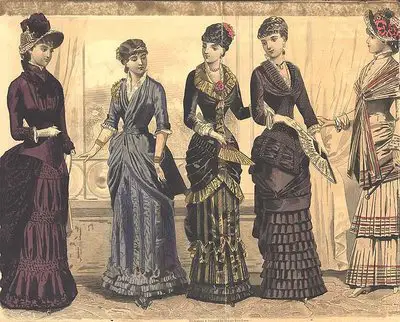
The reason for this change was that the size of the skirts had expanded and so pantalettes was more suited to this new change. The dresses worn by women during the day had a solid bodice. For the evening occasions, the Victorian women had some liberty as they could bear the shoulders and upper part of the chest. This apparel was completed by a shawl and opera-length gloves.
This was the case of upper and middle-class women. Shawls also formed a part of the Victorian costume. By 1860, the skirts were flat at the front. The day dresses had pagoda sleeves and a high neckline. These necklines either had lace or tatted collar on them. However, for the evening wear, the gowns had a low neckline and short sleeves along with appropriate gloves.
Somewhere in 1870, tea-gowns were introduced for casual get-togethers at home. By 1867 Crinoline was replaced by Bustles to hold the skirts up. The invention of the sewing machine in the late 18th century enabled women to wear sewn clothes. The use of machine brought about a lot of change in the clothing fashion.
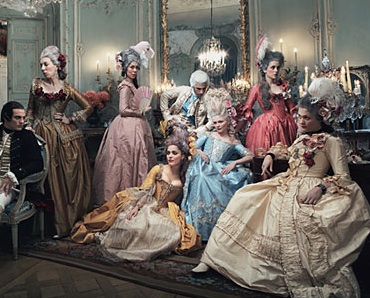
Victorian Era Women’s Fashion: Skirts
Jacket and skirts which matched the hunting outfit were worn in the 1880s. The shirt was high collared and the top-hat had a veil. The skirts worn for hunting purposes were up to the ankle-length accompanied with proper boots. Women while going for a walk wore long jackets and a skirt, with bustle and a small hat or bonnet.
By 1887, the sleeves of the dresses had become slimmer and close-fitting. The women’s gowns during the 1880s were primarily made in two colors material namely, deep red, peacock blue, royal blue, purple, etc. These colors were either used alone or in combination or in tartan fabrics. During the 1890s the women’s fashion was simple as compared to the earlier years.
Women did not use bustles and crinoline and the dresses were no longer tight fitted. Corsets were longer giving the women a slight S-curve silhouette. Skirts worn were closely fitted over the hip and flared just above the knees. Women preferred high necks and puffed sleeves. Also, sportswear like the bicycling dress, tennis dress, etc was worn by women.
The sleeves changed from slim to leg of mutton sleeves at the end of Victorian times. By 1895 the sleeves were very puffed like those worn by women in 1833. The late Victorian women wore sharper tailored jackets which gave them an altogether different posture and confidence.
Victorian era women’s wear timeline
1830s dress style
During the early years of Queen Victoria’s reign in 1837, the ideal shape of the Victorian woman was a long slim torso emphasised by wide hips.
To get a low and slim waist, tightly laced corsets were used that extended over the abdomen and down towards the hips. The corset was commonly worn over a chemise. The tight-fitting bodice with a low waistline was over the corset. Read more about history of Corsets and Corset Punishments.. Read more about history of Corsets and Corset Punishments.. A long skirt accompanied the bodice, with layers of horsehair petticoats worn underneath to create fullness; emphasising the small waist. The narrow waist was contrasted by low and straight necklines.
Women’s dresses had larger sleeves than were worn in any period before or since and were accompanied by elaborate hairstyles and large hats.
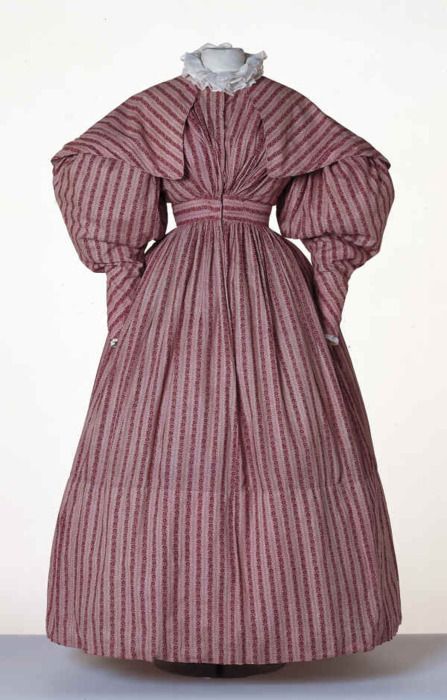
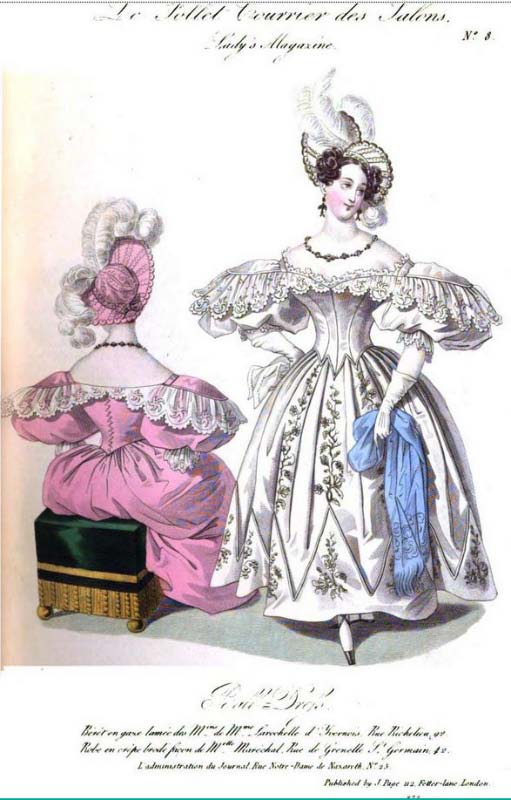
1840s dress style
Key features were low neckline, collapsed sleeves, elongated V-shaped bodices, and fuller skirts.
Skirts lengthened with increased width with the arrival of the horsehair crinoline in 1847; which became a status symbol of wealth.
More layers of flounces and petticoats emphasised the fullness of the wide skirts. Skirts were attached to bodices with very tight organ pleats secured at each fold. This served a decorative purpose for a relatively plain skirt. The 1830s was flamboyant whereas 1840s style was perceived as conservative and “Gothic” compared to the 1830s.
1850s dress style
Day dress necklines dropped even lower into a V-shape. So the bust area was covered with a chemisette.
Evening dress featured a Bertha, exposing the shoulder area instead. Bodices extended over the hips, sleeves opened further and increased in fullness. The volume and width of the skirt increased even further, especially during 1853 with the addition of rows of flounces. The invention of synthetic dyes introduced new colours to garments and women tried gaudy and bright colours.
1860s dress style
Size of crinolines decreased in size at the top, but retained their amplitude at the bottom.
Its shape became flatter in the front and more voluminous behind.
Bodices ended at the natural waistline, had wide pagoda sleeves, high necklines and collars for day dresses and low necklines for evening dresses.
1870s dress style
Broad skirts trend slowly vanished in the and women prefered an even slimmer silhouette. Bodices had natural waistline, necklines varied, and sleeves began under the shoulder line.
1880s dress style
The bustle re-appeared in 1883, and featured a further exaggerated horizontal protrusion at the back. Drapery moved towards the sides or front panel of the skirt and at the back was lifted up into poufs. Bodices were shortened and ended above the hips.
1890s dress style
By 1890, the crinoline and bustle were completely abandoned. Skirts naturally flared away from the tiny waist and evolved into a bell shape. High necklines, sleeves of bodices peaked at the shoulders, which increased in size during 1894.
After the mid-19th century, three important events impacted women’s fashion.
1. The invention of the sewing machine – speed and quality of sewing improved dramatically.
2. The invention of synthetic dyes – it created intense fabric colours
3. Bustles – the fashionable shape of crinolines changed with a flat front, in time for the arrival of the bustle.
By 1883 the bustles became really popular. It was an uncomfortable garment which made sitting in the chair difficult.
Dresses in this period were strictly regulated, and the incorrect dress would mean getting censured from the influential ladies of high fashion.
Also, check out women’s hats, Women’s Shoes, bathing costumes. and Step by step guide to making a Victorian-era dress.